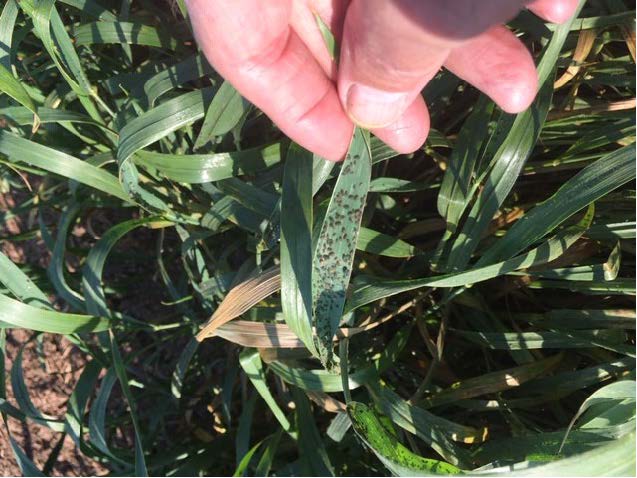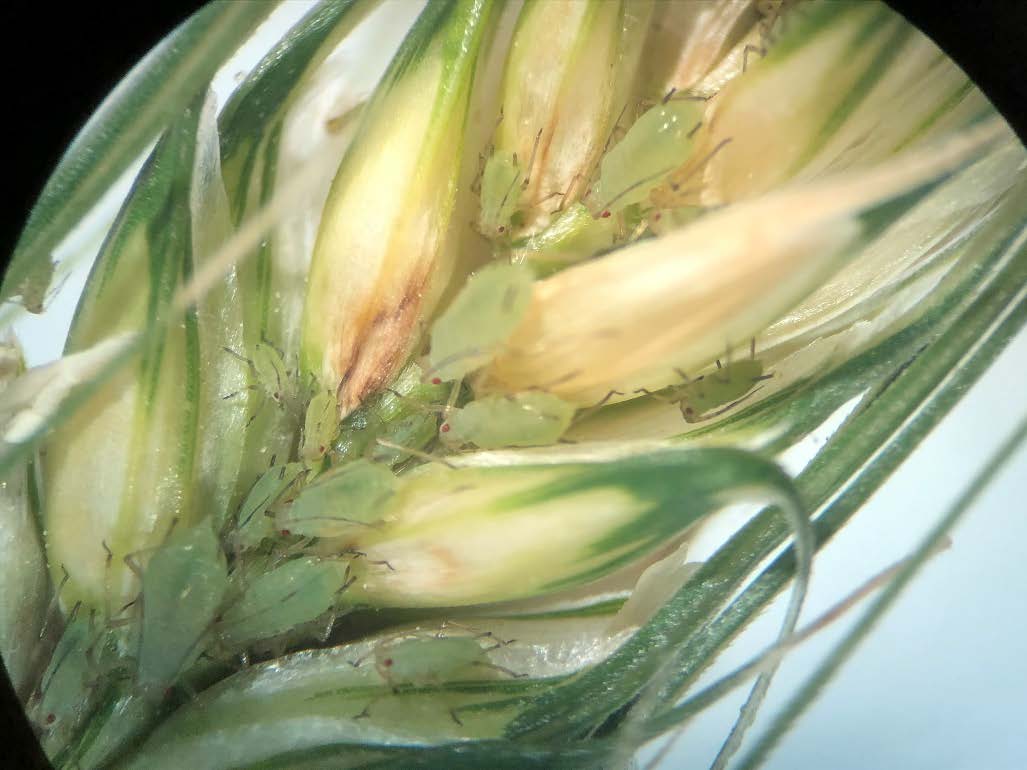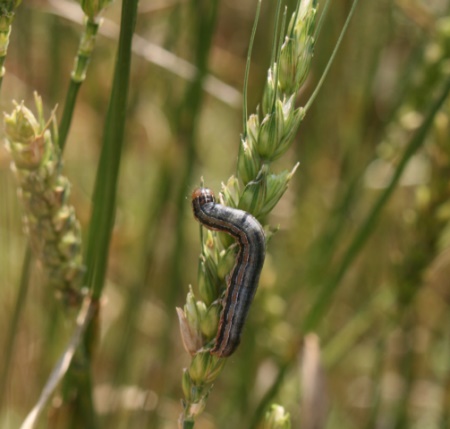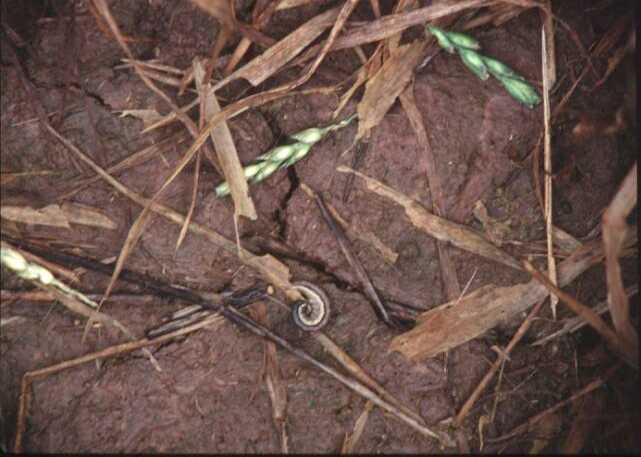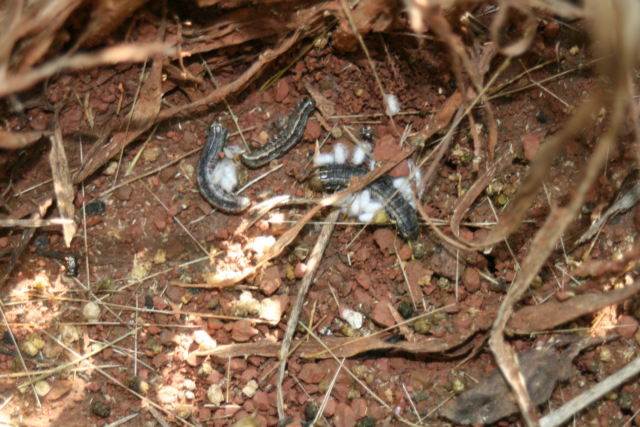Aphids: Bird Cherry-Oat Aphids and an Invasion by the “English” (Grain Aphid that is) and Armyworms: Decisions…
The good news is that Oklahoma has a healthy, good-looking wheat crop. Now, it must be protected from any swarming hordes of insect pests that want to eat it! Dr. Kris Giles has been surveying wheat fields in SW and Central Oklahoma. I have been collecting data from our wheat plots in Chickasha, Stillwater, and Lahoma. Dr. Giles found increasing bird cherry oat aphid (BCOA) numbers, and its main natural enemy (Lysiphlebus testaceipes) may have been set back by the record cold temperatures that we experienced in February. I have seen mixed populations of English grain aphids and bird cherry oat aphis in our wheat plots.
Sometimes, aphid infestations are overlooked. Bird cherry-oat aphid infestations do not produce visible damage until they become very numerous and English grain aphids often bury themselves in between the seeds where they blend in. So check your field for bird cherry oat aphid, English grain aphids.
Bird cherry oat aphids are olive green to dark green with two rusty patches that surround their “tailpipes” (cornicles). They feed on plant juices with their piercing sucking mouthparts. They can reproduce rapidly, so fields should be scouted to make a determination as to the need to control them.
Bird Cherry Oat Aphid:

Lady beetles and most importantly, the Lysiphlebus wasp that parasitizes them, often control bird cherry oat aphids. Parasitized aphids swell up and form “mummies” that can easily be seen (below). If an aphid infestation has 10-15% mummies, the rest are probably also parasitized.
BCOA and Aphid Mummy:
English grain aphid is larger than either greenbug or bird cherry oat aphid (0.125 inches), green with long black cornicles and legs that have alternate bands of green and black. Their appearance is sometimes characterized as “spidery”. Suggested thresholds are 5 per stem at flag leaf, and 10 per stem at head emergence through milk stage.
English Grain Aphids in Wheat Heads:
My suggestion is to scout the field beforehand to determine if there are GROWING numbers of bird cherry oat aphids that could be or are of concern. Count bird cherry oat aphids on each of 25 randomly selected tillers across a zigzag transect of the field and note mummy activity. If 10 to 20% of bird-cherry oat aphids are mummies, and there are numerous lady beetle larvae in the wheat, consider control. If wheat heads have emerged, look for English grain aphids imbedded in the head.
Unpublished research provided by Dr. Kris Giles (OSU) and Dr. Norm Elliott (USDA-ARS) combined with studies on spring wheat from the Dakotas and Minnesota indicate that 20-40 BCOA per tiller causes 5-9% yield loss before wheat reaches the boot stage. My suggestions: if BCOA numbers average 10-20 per tiller, figure on a 5% loss, if 20-40 per tiller, figure a 7% loss, and if BCOA aphids are more than 40 per tiller, figure a 9% loss.
Estimate APHIDS PER TILLER_______ /tiller =
Total # aphids ______/25 tillers
Estimate CROP VALUE $_______/acre =
Expected yield ______bushels/acre X $ _____/bushel
Calculate CONTROL COSTS $______/acre =
Insecticide $______/acre + Application $____/Acre
PREVENTABLE LOSS $_____/acre =
Crop value $________ X______loss from aphids/tiller
If PREVENTABLE LOSS IS GREATER THAN CONTROL COSTS = TREAT
IF PREVENTABLE LOSS IS LESS THAN CONTROL COSTS = DON’T TREAT
Here is a Table of Preventable Loss estimates for bird cherry-oat aphids for expected yields of 30 to 50 bushels per acre, expected wheat prices of $3.00, $3.50, and $4.00 per bushel, and bird cherry-oat aphid numbers of 10-20, 20 to 40, and over 40 per tiller.
| Expected Yield (Bushels/Acre) | Expected Price ($ per bushel) |
Crop Value ($ per acre) |
10-20 aphids/tiller |
20-40 aphids/tiller | More than 40/tiller |
|---|---|---|---|---|---|
| Preventable Loss from BCO Aphids ($ per acre) | |||||
| 30 | $3.50 | $105.00 | $5.25 | $7.35 | $9.45 |
| 35 | $3.50 | $122.50 | $6.13 | $8.58 | $11.03 |
| 40 | $3.50 | $140.00 | $7.00 | $9.80 | $12.60 |
| 45 | $3.50 | $157.50 | $7.88 | $11.30 | $14.18 |
| 50 | $3.50 | $175.00 | $8.75 | $12.25 | $15.75 |
| 30 | $4.00 | $120.00 | $6.00 | $8.40 | $10.80 |
| 35 | $4.00 | $140.00 | $7.00 | $9.80 | $12.60 |
| 40 | $4.00 | $160.00 | $8.00 | $11.20 | $14.40 |
| 45 | $4.00 | $180.00 | $9.00 | $12.60 | $16.20 |
| 50 | $4.00 | $200.00 | $10.00 | $14.00 | $18.00 |
| 30 | $4.25 | $127.50 | $6.38 | $8.93 | $11.48 |
| 35 | $4.25 | $148.75 | $7.43 | $10.40 | $13.37 |
| 40 | $4.25 | $170.00 | $8.50 | $11.90 | $15.30 |
| 45 | $4.25 | $191.25 | $9.56 | $13.38 | $17.20 |
| 50 | $4.25 | $212.50 | $10.62 | $14.87 | $19.12 |
This cool, rainy spring weather, while providing excellent growing conditions for wheat, is also foodstuff for “producing” armyworms. Armyworm infestations typically occur in late April through the first two weeks of May. They feed on leaves and awns, (below, top) and occasionally clip the head from developing plants. The head clipping (below, bottom) I have noticed over the years is mostly restricted to secondary tillers with very small, green heads that contribute very little to yield.
Since armyworm infestations tend to occur more frequently around waterways, areas of lush growth, or areas with lodged plants, check them first to determine the size of the infestation. Early signs of an infestation include chewed leaves with ragged margins. You may find “frass” i.e. the excrement from armyworm caterpillars, around the base of wheat stems and clipped heads. Also, look for evidence of armyworms parasitized by the wasp Glyptapanteles militaris. This parasitoid attacks armyworms as well as several other caterpillars. When the larva emerges, it produces a cottony cocoon (below, bottom) about the size of a Q-tip. Scout for armyworms at five or more locations looking for “curled up worms” (below, top)
Armyworm caterpillars tend to feed at night, so another good strategy is to bring a flashlight, shine it on the emerged wheat heads after dusk and count armyworms that are feeding on the heads and plant stems.
The suggested treatment threshold for armyworms is 4-5 caterpillars per linear foot of row (below). Generally, no control is needed if wheat is past the soft dough stage unless there is visible head clipping, and caterpillars are present and feeding.
If a producer is considering a fungicide application, this might be an opportune time to evaluate your field for bird cherry oat aphid, English grain aphid and/or armyworms. If NEEDED, combine an insecticide with a needed fungicide application to control multiple pests. Check CR-7194, “Management of Insect and Mite Pests in Small Grains” for registered insecticides, application rates, and grazing/harvest waiting periods. It can be obtained from any Oklahoma County Extension Office.

